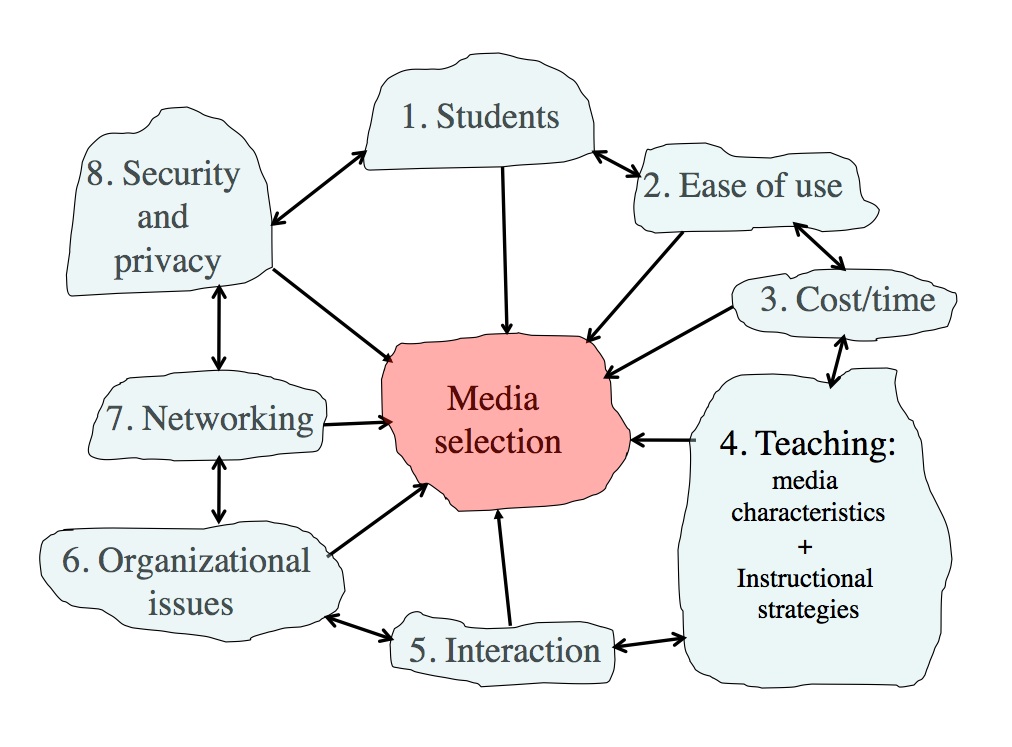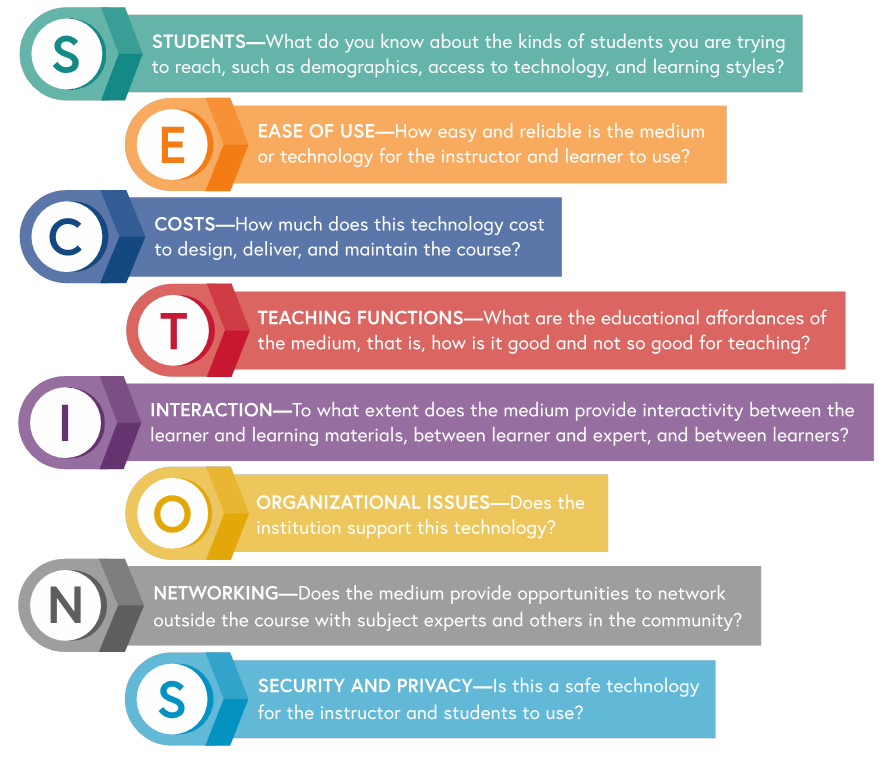Chapter 10: Choosing and using media in education
10.1 Models for media selection

10.1.1 What the literature tells us
Given the importance of the topic, there is relatively little literature on how to choose appropriate media or technologies for teaching. There was a flurry of not very helpful publications on this topic in the 1970s and 1980s, but relatively little since (Baytak, undated). Indeed, Koumi (1994) stated that:
there does not exist a sufficiently practicable theory for selecting media appropriate to given topics, learning tasks and target populations . . . the most common practice is not to use a model at all. In which case, it is no wonder that allocation of media has been controlled more by practical economic and human/political factors than by pedagogic considerations (p. 56).
Mackenzie (2002) comments in a similar vein:
When I am discussing the current state of technology with teachers around the country, it becomes clear that they feel bound by their access to technology, regardless of their situation. If a teacher has a television-computer setup, then that is what he or she will use in the classroom. On the other hand, if there is an LCD projector hooked up to a teacher demonstration station in a fully equipped lab, he or she will be more apt to use that set up. Teachers have always made the best of whatever they’ve got at hand, but it’s what we have to work with. Teachers make due.
Mackenzie (2002) has suggested building technology selection around Howard Gardner’s multiple intelligences theory (Gardner, 1983, 2006), following the following sequence of decisions:
learner → teaching objective → intelligences → media choice.
Mackenzie then allocates different media to support the development of each of Gardner’s intelligences. Gardner’s theory of multiple intelligences has been widely tested and adopted, and Mackenzie’s allocations of media to intelligences make sense intuitively, but of course it is dependent on teachers and instructors applying Gardner’s theory to their teaching.
A review of more recent publications on media selection suggests that despite the rapid developments in media and technology over the last 20 years, my ACTIONS model (Bates, 1995) is one of the major models still being applied, although with further amendments and additions (see for instance, Baytak, undated; Lambert and Williams, 1999; Koumi, 2006). Indeed, I myself modified the ACTIONS model, which was developed for distance education, to the SECTIONS model to cover the use of media in campus-based as well as distance education (Bates and Poole, 2003).
Patsula (2002) developed a model called CASCOIME which includes some of the criteria in the Bates models, but also adds additional and valuable criteria such as socio-political suitability, cultural friendliness, and openness/flexibility, to take into account international perspectives. Zaied (2007) conducted an empirical study to test what criteria for media selection were considered important by faculty, IT specialists and students, and identified seven criteria. Four of these matched or were similar to Bates’ criteria. The other three were student satisfaction, student self-motivation and professional development, which are more like conditions for success and are not really easy to identify before making a decision.
Koumi (2006) and Mayer (2020) have come closest to to developing models of media selection. Mayer has developed twelve principles of multimedia design based on extensive research, resulting in what Mayer calls a cognitive theory of multimedia learning. (For an excellent application of Mayer’s theory, see UBC Wikis.) Koumi (2015) more recently has developed a model for deciding on the best mix and use of video and print to guide the design of xMOOCs.
Mayer’s approach is valuable at a more micro-level when it comes to designing specific multimedia educational materials, as is Koumi’s work. Mayer’s cognitive theory of multimedia design suggests the best combination of words and images, and rules to follow such as ensuring coherence and avoiding cognitive overload. When deciding to use a specific application of multimedia, it provides very strong guidelines. It is nevertheless more difficult to apply at a macro level. Because Mayer’s focus is on cognitive processing, his theory does not deal directly with the unique pedagogical affordances or characteristics of different media. Neither Mayer nor Koumi address non-pedagogical issues in media selection, such as cost or access. Mayer and Koumi’s work is not so much competing as complementary to what I am proposing. I am trying to identify which media (or combinations of media) to use in the first place. Mayer’s theory then would guide the actual design of the application. I will discuss Mayer’s twelve principles further in Section 5 of this chapter, which deals with teaching functions.
Puentedura’s SAMR model (2014), discussed later in this chapter, is valuable for assessing the choice of a particular medium, but it focuses solely on pedagogical issues, particularly in terms of whether the choice augments or transforms learning. Although this is a powerful criterion for media selection, the SAMR model does not take into account other essential factors in media selection, such as cost or ease of use. It is though a useful way to assess decisions on media selection, once decisions have been made.
It is not surprising that there are not many models for media selection. The models developed in the 1970s and 1980s took a very reductionist, behaviourist approach to media selection, resulting in often several pages of decision-trees, which are completely impractical to apply, given the realities of teaching, and yet these models still included no recognition of the unique affordances of different media. More importantly, technology is subject to rapid change, there are competing views on appropriate pedagogical approaches to teaching, and the context of learning varies so much. Finding a practical, manageable model founded on research and experience that can be widely applied has proved to be challenging.
10.1.2 Why we need a model
At the same time, every teacher, instructor, and increasingly learner, needs to make decisions in this area, often on a daily basis. A model for technology selection and application is needed therefore that has the following characteristics:
- it will work in a wide variety of learning contexts;
- it allows decisions to be taken at both a strategic, institution-wide level, and at a tactical, instructional, level;
- it gives equal attention to educational and operational issues;
- it will identify critical differences between different media and technologies, thus enabling an appropriate mix to be chosen for any given context;
- it is easily understood, pragmatic and cost-effective;
- it will accommodate new developments in technology.
For these reasons, then, I will continue to use the Bates’ SECTIONS model, with some modifications to take account of recent developments in technology, research and theory. The SECTIONS model is based on research, has stood the test of time, and has been found to be practical. SECTIONS stands for:

I will discuss each of these criteria in the following sections, and will then suggest how to apply the model.
References
Bates, A. (1995) Technology, Open Learning and Distance Education London/New York: Routledge
Bates, A. and Poole, G. (2003) Effective Teaching with Technology in Higher Education San Francisco: Jossey-Bass/John Wiley and Son
Baytak, A.(undated) Media selection and design: a case in distance education Academia.edu
Gardner, H. (1983) Frames of Mind: The Theory of Multiple Intelligences New York: Basic Books
Gardner, H. (2006) Multiple Intelligences: New Horizons and Theory in Practice New York: Basic Books
Koumi, J. (1994). Media comparisons and deployment: A practitioner’s view British Journal of Educational Technology, Vol. 25, No. 1
Koumi, J. (2006). Designing video and multimedia for open and flexible learning London: Routledge
Koumi, J. (2015) Learning outcomes afforded by self-assessed, segmented video–print combinations Cogent Education, Vol. 2, No.1
Lambert, S. and Williams R. (1999) A model for selecting educational technologies to improve student learning Melbourne, Australia: HERDSA Annual International Conference, July
Mackenzie, W. (2002) Multiple Intelligences and Instructional Technology: A Manual for Every Mind Eugene, Oregon: ISTE
Mayer, R. E. (2020) Multimedia Learning (3rd ed). New York: Cambridge University Press.
Patsula, P. (2002) Practical guidelines for selecting media: An international perspective The Useableword Monitor, February 1
Puentedura, R. (2014) SAMR and Bloom’s Taxonomy: Assembling the Puzzle common sense education, September 24
UBC Wikis (2014) Documentation: Design Principles for Multimedia Vancouver BC: University of British Columbia
Zaied, A. (2007) A Framework for Evaluating and Selecting Learning Technologies The International Arab Journal of Information Technology, Vol. 4, No. 2
Activity 10.1 Making a preliminary decision on media selection
1. Choose a course that you are teaching or may be teaching. Identify what media or technologies you might be interested in using. Keep a note of your decision and your reasons for your choice of media/technologies.
When you have finished reading this chapter you will be asked to do a final activity (Activity 10.10) and then you can compare your answers to both this activity and Activity 10.10 after reading the whole chapter.
There is no feedback provided for this activity.

